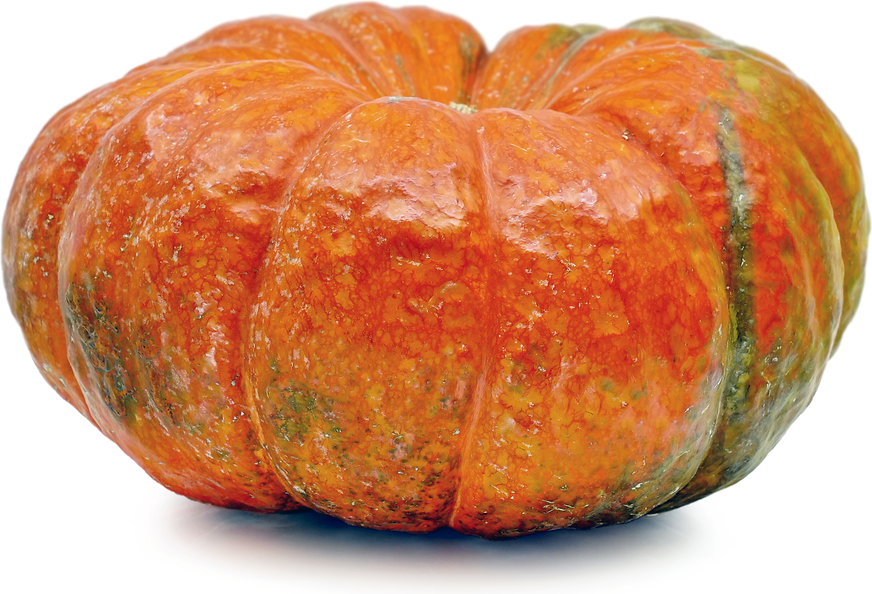


Cinderella Pumpkins
Estimated Inventory, 24" Bin : 0
This item was last sold on : 11/27/24
Description/Taste
Cinderella pumpkins are medium to large in size, averaging 30 to 46 centimeters tall, 30 to 38 centimeters wide, and 7 to 11 kilograms in weight. This variety has a round shape with a flattened blossom and stem end. Their deeply ribbed rind matures from yellow to a vibrant red-orange, adorned with small, circular bubbles and splotches of green striping on its surface. Cinderella pumpkins have a smooth, glossy outer texture with a rough, light brown stem. These dense pumpkins contain a central cavity surrounded by a thick outer layer of light orange flesh. The flesh has a firm texture when raw but becomes soft and tender when cooked. It's connected to a stringy pulp filled with flat, cream-colored seeds. When cooked, Cinderella pumpkins are creamy and moist with a mild and slightly sweet flavor.
Seasons/Availability
Cinderella pumpkins are available from fall to winter.
Current Facts
Cinderella pumpkins are botanically classified as Cucurbita maxima and belong to the Cucurbitaceae family along with gourds and squash. They are a French heirloom variety as well as a winter squash that grows on sprawling vines reaching over three meters in length. This variety is commonly known as Rouge Vif d’Etampes, which translates to vivid red in English, a nod to the pumpkins’ brightly-colored rind. They are also referred to as cheese pumpkins due to their flat, cheese wheel-like shape. Because of their whimsical name, this variety is often confused with Fairytale pumpkins. These have a similar shape to Cinderella pumpkins but possess an orange-brown hue rather than a bright orange one. Today, Cinderella pumpkins are predominately ornamental but are also used by home gardeners and chefs for soups and pies.
Nutritional Value
Cinderella pumpkins are rich in vitamin A, supporting eye health, enhancing immune function, and promoting healthy skin through their high beta-carotene content. Their abundance of vitamin C provides strong antioxidant protection, boosts the immune system, aids in collagen production for skin and tissue repair, and improves iron absorption, contributing to overall vitality. The vitamin B6, or pyridoxine, found in these pumpkins plays a crucial role in brain function, helping in neurotransmitter production to regulate mood and improve cognitive abilities, while also supporting energy metabolism and red blood cell formation. The high potassium content in Cinderella pumpkins helps maintain heart health by regulating blood pressure, supporting nerve and muscle function, and preventing muscle cramps.
Applications
Cinderella pumpkins are best suited for cooked applications such as roasting, baking, and steaming. Their sweet flavor and creamy texture make them ideal for baked goods and desserts like pies, breads, muffins, cookies, and cakes. They can also be frozen and used to make pumpkin ice cream, smoothies, or gelato. Cinderella pumpkins are frequently puréed for pumpkin butter, soups, stews, or casseroles. They may be hollowed out and used as a decorative bowl for stuffing with candy or other Halloween decorations. Cinderella pumpkins pair well with meats such as sausage, poultry, bacon, or turkey, carrots, celery, parsnips, rutabagas, cabbage, green and red bell peppers, broccoli, zucchini, corn, mushrooms, garlic, onions, chives, cream cheese, cinnamon, honey, rice, quinoa, parsley, Italian seasoning, rosemary, thyme, and cheese such as cheddar, Emmenthal, or Gruyere. Cinderella pumpkins will keep for 3 to 5 months when stored in a cool, dry place. When cooked, they can last up to 3 days in the fridge or 3 to 6 months in the freezer in their puréed form.
Ethnic/Cultural Info
This variety is believed to have served as the original inspiration for the horse-drawn carriage featured in Disney's classic 1950 animated film Cinderella. The animators who worked on this film were said to have brought these pumpkins into the studio to study their rich color palettes and intricate textures. These artists created multiple variations of the pumpkin before the final version of the carriage was chosen. After the release of the film, the Rouge Vif d’Etampe pumpkin earned a new name, the Cinderella pumpkin, which is what it's most commonly referred to as in the United States today. This variety remains closely associated with the film and serves as an emblem of Disney's retelling of the Cinderella story.
Geography/History
Cinderella pumpkins are native to France. Their French name was derived from their site of origin, the small medieval town of Etampes located about 48 kilometers southwest of Paris. They grow in climates with warm temperatures, full sun exposure, and well-drained soils. Cinderella pumpkins are a cultivated variety that’s been bred for their distinct flattened shape and vibrant color, both commercially and in home gardens. Cinderella pumpkins were the most popular variety found in Parisian street markets during the 1880s. In 1883, Washington Atlee Burpee of Burpee Seeds purchased and introduced Cinderella pumpkins to the United States where it is now a niche variety that's popular during the autumn and early winter seasons. Today, Cinderella pumpkins can be found at specialty stores and farmers markets in Europe, the United States, Asia, and Australia.
Recipe Ideas
Recipes that include Cinderella Pumpkins. One

















